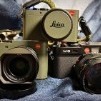Leica S3
-
Recently Browsing 0 members
- No registered users viewing this page.
-
Similar Content
-
- 39 replies
- 4,169 views
-
- 2 replies
- 299 views
-
Leica Q3-S ??
By Jaclo,
- 9 replies
- 386 views
-
- 11 replies
- 531 views
-
- 561 replies
- 91,719 views
-




Recommended Posts
Join the conversation
You can post now and register later. If you have an account, sign in now to post with your account.
Note: Your post will require moderator approval before it will be visible.